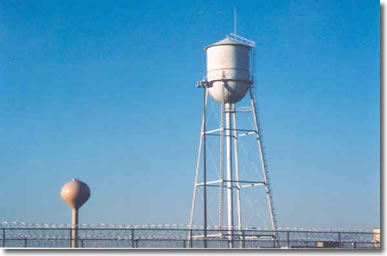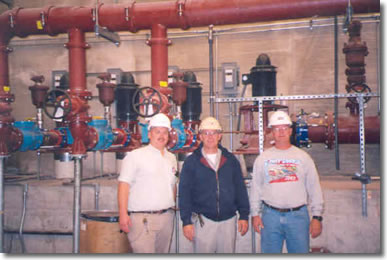Drinking Water Protection
- Drinking Water Protection Home
- About Us
- A-Z Index of Contaminants in Water
- Community Public Water Supply
- Drinking Water Grants and Loans
- Drinking Water Institute
- Drinking Water in Schools and Child Cares
- Drinking Water Revolving Fund
- Laws and Rules
- Noncommunity Public Water Supply
- Source Water Protection
- Water Operator and Certification Training
- Drinking Water Protection Contacts
Related Topics
- Annual Reports
- Drinking Water Risk Communication Toolkit
- Drinking Water Protection External Resources
- Fact Sheets
- Forms
- Invisible Heroes Videos: Minnesota's Drinking Water Providers
- Noncom Notes Newsletter
- Sample Collection Procedures (videos, pictures, written instructions)
- Waterline Newsletter
Related Sites
- 10 States Standards
- Clean Water Fund
- Health Risk Assessment – Guidance Values and Standards for Water
- Minnesota Well Index
- Water and Health
- Wells and Borings
Environmental Health Division
New Water Plant among Upgrades at Sandstone Correctional Institution
From the Winter 2005-06 Waterline
Quarterly Newsletter of the Minnesota Department of Health Public Water Supply Unit, Waterline
A complete list of feature stories can be found on the Waterline webpage.
 |
| The new (left) and old water towers at Sandstone. |
"It all hit at the right time," said Kent Faulkner, the plumbing supervisor at the Federal Correctional Institution (FCI) in Sandstone, Minnesota, a low-security facility for male offenders located approximately 90 miles north of the Twin Cities.
The facility opened in 1939 through a transfer of a group of selected inmates from the U.S. Penitentiary at Leavenworth, Kansas. The number of inmates through the 1940s was approximately 350 before a drop in population, which caused the institution to be closed and converted into a mental health hospital from 1949 to 1959. It then resumed its status as a federal prison, and the current inmate population hovers around 920.
In the early 1990s, the U. S. Bureau of Prisons (BOP) did an infrastructure survey of all their prisons that were more than 50 years old. The survey determined that Sandstone was still functional but would need some infrastructure upgrades. Around this time, new rules regarding radium and radon in drinking water were being promulgated by the U. S. Environmental Protection Agency, adding another issue that the prison would have to deal with. In addition, a decision was made by BOP to expand the housing for prisoners with a new building that would increase the facility’s capacity by 500. (Faulkner noted that when he started at Sandstone in 1986, the entire federal prison system had approximately 44,000 inmates. That number has more than quadrupled, to more than 186,000, in fewer than 20 years, creating a need for more space. The prison in Sandstone is outside of town, allowing for room to expand.)
As a result of all this, the prison began a $20 million dollar project in late 2003 that includes a new powerhouse, boiler, and water treatment plant, all under the same roof. The water upgrades include a new 150,000 gallon clearwell and 400,000 gallon tower.
Unlike the existing plant and tower, the new facility will be outside the prison fences. Not only will this make it easier for deliveries to be made, it satisfies a BOP desire to have such important functions outside the secured area. This way, in the event of a loss of control of the prison itself, the water and power facilities would not be in the hands of the inmates.
The existing water treatment system goes back to the opening of the prison. Two wells (one outside the fence and the other next to the treatment plant, which is directly underneath the existing 150,000 gallon tower) feed the plant, which has one pressure filter. The primary function of the plant had been iron reduction, and the chemical addition included potassium permanganate, caustic soda, zinc orthophosphate, and chlorine.
When the need came to also reduce radiological chemicals, Faulkner looked at the experience of the city of Hinckley, which is about 10 miles away. Sioux Valley Environmental (SVEN) in Renner, South Dakota, worked with the city on their problem, and J. R. Yde of SVEN then provided direction for Sandstone FCI. Yde asked for a sample of water, which Faulkner sent, and on the basis of that Yde made recommendations for chemical changes, including manganese sulfate.
By adjusting the chemical types and dosages, as well as insertion points, Faulkner said they were able to reduce their combined Gross Alpha Emitters from 24.0 picocuries per liter (pC/L) to 5.4 pC/L with the addition of manganese sulfate. The combined radium 226/228 dropped from 7.4 pC/L to 1.7 pC/L. However, this required the filter to be backwashed three times a day.
The new plant will have two gravity filters, each with a surface area of 10 x 12 feet. The media consists of 18 inches of anthracite on top of 12 inches of sand. The new plant will be able to produce 500 gallons per minute (gpm), as compared to 320 gpm with the current plant. The existing wells will be abandoned, and two new wells, each 460 feet deep, have been drilled outside the new building.
Faulkner says the new plant has been designed to do the same chemical process but on a much larger scale. They went to gravity filters with aeration to address the radon issues. A bonus is that the aeration raises the pH of their water, which means they will use less caustic soda.
Process
Water from the wells goes first to the aerator and then drops to the detention basin as caustic soda, potassium permanganate, chlorine, and manganese sulfate are added. The travel time through the basin is about 30 minutes. The water then goes through the filters and flows into the clearwell and wet well as zinc orthophosphate is added for corrosion control. Faulkner said they anticipate backwashing every three days (instead of the current practice of three times a day). From the clearwell, three high-service pumps raise the water into the tower.
Marc Wolff, the project representative for the Bureau of Prisons, noted the self-sufficiency of the new facility, which is a need of the setting. "Redundancy is always built in."
The existing plant is staffed around-the-clock, as will be the case with the new plant. Inmates have helped out, performing hourly readings and backwashes. Since the new plant will be automated, inmates will be limited to cleaning and doing preventive and general maintenance unless they get a license. Faulkner said that although inmates have helped with the water operations, they have not expressed interest to be licensed, as they have with some of the other functions. "They get their plumbing or electric license and that's the field they go into," Faulkner explained. "That's the goal behind the Bureau's philosophy. We get a person here and as long as they're incarcerated, we try to give them a trade they can take on the street and make themselves better versus turning back to the life that got them here."
Faulkner hopes that the new plant may inspire some to get their water-operation license so they can do more in the plant and possibly pursue a career in water after their release. "The more trained inmates we get, the better. With the new state of the art plant, there may be more interest among inmates to get their licenses."
Schoell & Madson, Inc. of Minnetonka, Minnesota, designed the tower and wells, and Progressive Consulting Engineers, Inc. of Brooklyn Center, Minnesota, designed the water plant. The general contractor is LS Black Constructors, Inc. of St. Paul.
 |
| From left to right, Marc Wolff of the Bureau of Prisons, Kent Faulkner of Sandstone, and Doug Kissick of L. S. Black Constructors, the general contractor, in front of the high service pumps.. |